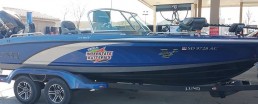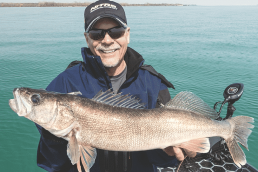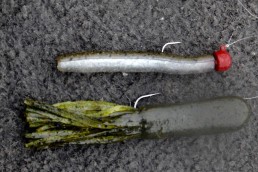Rig ’em Right: New Boats are Your Blank Canvas
SHARE THIS POST
A boat is to an angler as what a tool chest is to a carpenter. You can’t grab the right tool at the right time if things are in the wrong place. Proper rigging and components of your boat is critical. This is the time when things can get screwed up; it can be a very complicated or simple component to a successful day on the water.
Unfortunately, rigging is also often the phase of boat assembly that gets the least attention. For one thing, many anglers fail to realize that accessories and good rigging (trolling motors, kicker motors, fishing electronics, batteries) can add $4,000 to $6,000 to the cost of a quality boat. It pays big premiums to get it right the first time when that kind of money is invested.
Worse yet, fishermen often leave critical decisions to fishing store salesmen who may not fish as much. Their intentions may be good, but salesmen cannot know what type of fishing the boat will be expected to do.
Here are some questions to ask: How much do you want to spend? Are you a tournament angler or a guide who is going need top-of-the-line gear to gain an edge? Are you just a weekend angler who can get satisfactory results without all the costly bells and whistles? Do you need boat control from the bow for precise jigging and casting?
For the last one, if so, don’t under-power the boat. Get the biggest powered electric trolling motor you can afford. Make sure the shaft is long enough to stay in the water, even in rough conditions. Minn Kota’s Ulterra trolling motor is a perfect example of a motor that is quiet, powerful, and has a wide range of shafts, lengths and thrust options for different sizes and types of boats. The Ulterra also has an auto deploy and stow mechanism at the touch of a button.
Do you want to steer the kicker motor by hand? An on-console boat’s kicker motors can be linked to the main motor and maneuvered with the steering wheel. But with that configuration, steering radius is often sacrificed. Would you benefit from a remote-controlled auto pilot system for nearly hands-free control?
Also, do you want to spend the money to link gasoline kickers and electric trolling motors to a GPS system for precise control? It can make the difference between fish or no fish when targeting a spot on a spot, or when trolling on big water.
Is your boat a tiny craft that will function well with a 12-volt electrical system? Or, is it a 21-foot Lund 219 Pro-V GL that needs a 36-volt system to drive all the accessories? Are your extra batteries needed and are they reliable? I have found Interstate Batteries to be the strongest and most reliable batteries that we have ever used.
The questions are similar when buying fishing electronics, according to Tim Price, pro staff manager for Humminbird Electronics: What kind of fishing is being done? How much fishing does the person do? What is the angler’s budget?
Are you enjoying this post?
You can be among the first to get the latest info on where to go, what to use and how to use it!
“If a guy is only going fishing a couple of times a year, then keep it simple,” Price said. “He is not going to want something complex; he doesn’t want to have to consult the owner’s manual every time. But if he fishes more often, he may want a more complex unit that provides more data, such as side imaging, CHIRP, large screens and high resolution with tons of pixels.”
If he is only going to troll the Great Lakes for suspended salmon, then he doesn’t need a unit that will “see” fish lying tight to the bottom, as walleyes often do. A salmon fisherman could do very well with a wider cone angle and lower frequency to cover more water. True, walleye fishermen troll, but there are times when you need that precise separation to tell a fish from the bottom. Only a narrow cone angle and higher frequency transducers can do that. High-end units can give multiple options for optimum performance in a wide range of uses.
Install transducers according to manufacturer specifications. When in doubt, phone them. You have the experience with every make and model of boat to know what positions are best.
Do you need a GPS? That answer is a no-brainer if you fish big water or structure-laden lakes. GPS gives you the ability to return to spots far from shore precisely and quickly. A GPS can increase fishing success and save time, even on small waters, by taking you back to your honey hole time and time again. They also increase safety in bad weather, when fog or rain decreases visibility and you need to find the launch ramp fast.
Whatever fishing electronics you choose, be sure to run power cords and test the units near the point of installation before you drill holes. Make sure they do not block other things you need.
The same goes for placing rod holders, according to Mark Lozelle, owner of Tempress Products, which makes Fish On rod holders. He adds that you should decide how many rod holders you want, depending on the states and the waters fished. Minnesota only allows one rod apiece; Wisconsin allows three per person when trolling on specific lakes.
Once you know how many, decide how you want them mounted. Should they be bolted to the railings or drilled and secured to the gunnels? Don’t drill any holes until you make certain the rod holder and the rod butt will not interfere with other things, like the throttle lever or the gunnel of the boat. Lund Boats have an ingenious feature called “Sport Trak,” which allows you to mount your rod holders on a sliding track that doesn’t require drilling holes into your boat. You just slide and position the rod holders anywhere along the length of the track.
Take the time to rig your boat properly. Careful consideration of the rigging and the components will help your boat become the best toolbox an angler can put together.
MWO
SHARE THIS POST
Did you enjoy this post?
You can be among the first to get the latest info on where to go, what to use and how to use it!
Ted Takasaki
Ted Takasaki is an International Fishing Hall of Fame professional angler who has been featured in many national outdoor magazines and television shows. Takasaki has appeared in front of thousands of angling enthusiasts and is considered one of America’s top walleye and multispecies anglers. Follow him on his Facebook page.



